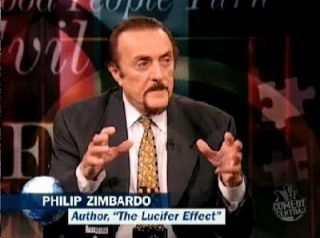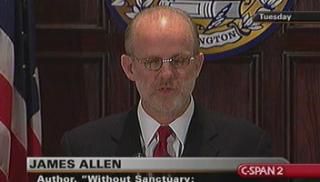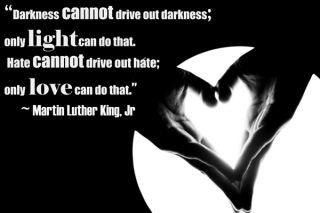Ethics and Morality
Discussing Evil: The Problem of “Us” and “Them”
The problem with thinking that violence is only a problem of the "other."
Posted June 9, 2014
Note to readers: This post has a strong trigger warning for discussion of evil and violence.

Photo via L.C.Nøttaasen
Not long after another tragic shooting shook the country, a mother wrote a blog post. She wrote:
“There's a pattern that has existed in my life for as long as I can remember. Not only do I do it, many other people that I know do it as well. I learn about some type of problem—a robbery, a shooting, a murder. About some type of horrific event...one of the many ways humans mistreat and harm one another. And of course, I am saddened for the victims, often offering up a silent prayer for them. But the very next instant, I do something else. I close my eyes for a moment, and then I brace myself as I await more information. And all the while one thought/prayer/chant/fear is running through my head:
‘Don't-let-them-be-black-don't-let-them-be-black-don't-let-them-be-black-don't-let-them-be-black-PLEASE GOD don't-let-them-be-black...’
Why? Because I am black. And I know that if the perpetrator IS black, like me, then there's yet another immense form of baggage that it will carry for me, for my children, for people who look like me, and for people who care about those who look like me. And no matter how many of us are honest, law-abiding, kind, non-violent people, we are erased every time the person who has done something wrong has skin that looks like mine.”
This pattern, she wrote, continues — but now has a new facet. Because two of her children now have an autism diagnosis. Her initial refrain, now has another verse. "Don't-let-them-be-autistic-don't-let-them-be-autistic-don't-let-them-be-autistic-don't-let-them-be-autistic-PLEASE GOD don't-let-them-be-autistic..."
She’s not alone. Since the heartbreaking events Memorial Day weekend, most of those I know in the autism community have been hunkered down, waiting out the storm of media attention, dreading each new article, each clip on TV. As we mourn along with the rest of the country, we face the knowledge that the way the media handles this event will have profound implications for ourselves and those we love. We brace ourselves, respond to questions, and wonder what is going to come next.
But even as we wonder, we know. Somewhere in the conversation, speculation will start. A debate about labels will begin. Sometimes it’s autism, sometimes it’s mental illness, sometimes it’s “being a loner,” and sometimes, it’s all of the above. If the perpetrator already has a diagnosis, or as in this case, the family “suspected” a specific diagnosis, the effect is all that much stronger. It’s an effect that usually does not have a good impact on the lives of those who bear that diagnosis. Stereotypes are strengthened. Relationships undermined. The factors that lead to exclusion are worsened.
Why such a focus on a label? Well, I believe it has a lot to do with how most of us tend to view the nature of evil. As Dr. Phil Zimbardo, a researcher who has dedicated much of his career to the study of good and evil, describes in his book The Lucifer Effect:

"We want to believe in the essential, unchanging goodness of people, in their power to resist external pressures, in their rational appraisal and then rejection of situational temptations. We invest human nature with god-like qualities, with moral and rational faculties that make us both just and wise. We simplify the complexity of human experience by erecting a seemingly impermeable boundary between Good and Evil. On one side are US, Our Kin, and Our Kind; on the other side of that line we cast Them, Their Different Kin, and Other Kind.”
For many who don’t live with one every day, diagnostic labels are very effective in casting the owner of the label as “other.” It can be a very effective shortcut to resolve the cognitive dissonance we all feel when tragedy happens. “How can this happen?,” we ask. How could someone do something so terrible? These are questions that many of us who have labels ask, too...but the answers we come up with are different.
The belief that violence is segregated to only those people with some kind of pathology (according to mainstream categorizations) is hard to accept unquestioningly when you’ve been the target of cruelty and violence from seemingly “normal” individuals for a significant portion of your life. When, in fact, many of the people in your life who provide respite from such violence are those who are also “othered” in the same way. It tends to challenge the accepted paradigms.
Looking at some of the most horrifying historical episodes of mass violence also call this easy stereotype into question. In Rwanda, average people raped, killed and tortured neighbors, friends, and even family members. And in WWII Europe, the Nazi party killed millions of jews, while many average citizens collaborated or at the very least turned the other way. Then there are the historical atrocities closer to home, against minority members of our own culture.
It’s something many in our country don’t want to talk about. It’s avoided, kept at a distance. From a distance, it can be minimized. From a distance, it can be easy to dismiss it as an abstraction and an aberration, something done only by a few bad apples, surreptitiously out in the woods somewhere. Read historical accounts, however, it’s not so easy to dismiss the horrific nature of these events (trigger warning) .
Even more difficult is the reality that much the of photographic evidence from this time frame came from the perpetrators themselves. Far from being a shameful thing hidden in the shadows, these events were boasted about with pride, and documented with photo postcards sent to relatives. Postcards which showed whole towns (including children), smiling into the camera, alongside the body of a being who had been tortured to death.

So many of these have survived to this today that one author, James Allen, published an entire book of them, many of which we can seen on his web site (warning: graphic, disturbing content). The work has been a cautionary tale for the author. In a narration of the slideshow posted on his web site, he states: “Studying these photos has engendered in me a caution of whites, of the majority, of the young, of religion, of the accepted. Perhaps a certain circumspection concerning these things was already in me, but surely not as actively as after the first sight of a brittle postcard of Leo Frank dead in an oak tree. It wasn't the corpse that bewildered me as much as the canine-thin faces of the pack, lingering in the woods, circling after the kill.”
Recently, this book came up in conversation with a colleague, who questioned why anyone would want to highlight such a thing. Truly, it’s not something you want to glorify. Thinking about it though, I’m reminded of another conversation I had some years ago with a different colleague. I had recently seen the movie Hotel Rwanda, and we were talking about it and the heartbreaking events it depicted. Offhand, I commented: “Thank God it could never happen here.”
My colleague’s response was quick, and stopped me cold. “Don’t be too sure,” he said. Drawing on his experiences growing up in Eastern Europe, and his travels, he reminded me of the many similar genocides that had happened throughout the world. Places he’d been to. Places which, he was quick to tell me, were not that different from where we lived. In that moment, I was deeply ashamed to realize the bias that had crept into my thinking. The binary thinking that we, as Americans, were somehow “better” than other human beings, and thus above this kind of atrocity. I was floored by my own arrogance, and later, my ignorance.
This brief exchange forced me recognize the extent that I used stereotyped “us” and “them” thinking with regard to violence, how I had used it to bolster my own feelings of safety and security at the expense of other human beings, and the role my own ignorance played in my ability to do so. Why was I prompted to do this? Well, we’ll do a lot of things to feel safe, even when that safety is, at some level, an illusion.
In his book, Zimbardo notes: “The need for security is a powerful determinant of human behavior. We can be manipulated into engaging in actions that are alien to us when faced with alleged threats to our security or the promise of security from danger.” How far does this need for safety go and what happens when this need combines with “us” and “them” thinking?
If you unquestioningly embrace the idea that violence, or any other trait deemed dangerous to society, is only the realm of some stereotyped “other,” in some peoples’ minds the solution is clear. Eliminate the “other.” The result of this is hate and violence toward the targeted group. People who have been part of a group targeted by this dynamic can describe it well — the violence, the fear, and the feeling of “erasure,” described by the author of the blog post I quoted earlier.

Graphic via Leland Francisco
Not long ago, someone on a social media platform shared a quote from Dr. Martin Luther King, Jr., which read, “Darkness cannot drive out darkness: only light can do that. Hate cannot drive out hate: only love can do that.” This quote has been on my mind ever since the Isla Vista shootings. I find myself thinking about what light looks like, in the wake of this darkness. What does it mean to respond with love? Thinking about loving the shooter, for me, is a stretch — but the caution against fighting hate with hate still resonates.
After the Sandy Hook shooting, fellow advocate Rachel Cohen-Rottenberg posted some examples of the hate that sprung up in the discussion after that event. One person advocated that we need to “crack down on crazy people” and “lock the [expletives] up.” Another wrote, “Autistics have gaping holes in their DNA and are therefore mutants. One cannot expect ‘normal’ human behavior behavior from a being that is indeed subhuman.” Another account told of a young man who attempted to buy a Christmas Tree at Wal-Mart who wound up with a black eye, split lip, and sprained shoulders, elbows and wrists, after a shopper (who knew of his diagnosis) jumped to conclusions when he reached into his pocket for a piece of paper.
Given these and many other examples, I find myself thinking that the most loving thing we can do, as we try to make sense of this horrible shooting, is to do what we can to avoid creating collateral damage in the process. That involves discomfort. It involves examining ugly realities and histories. It requires us to think deeply. To question ourselves, our motivations, and how we think about violence.
In my case, all that leads me to question — What would it look like if we treated violence not as a mental illness thing or an Asperger’s thing, but a human thing? How would that change the conversation?
For updates you can follow me on Facebook or Twitter. Feedback? E-mail me.
My book, Living Independently on the Autism Spectrum, is currently available at most major retailers, including Books-A-Million, Chapters/Indigo (Canada), Barnes and Noble, and Amazon.
To read what others have to say about the book, visit my web site: www.lynnesoraya.com.




